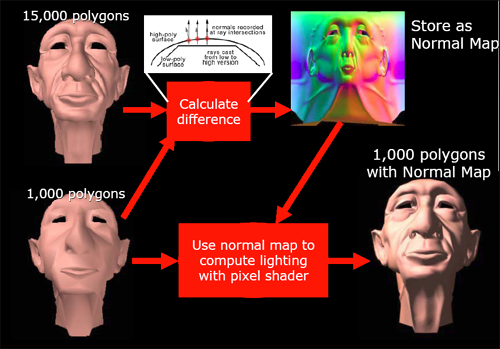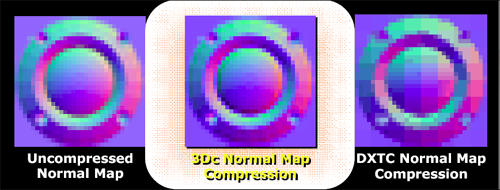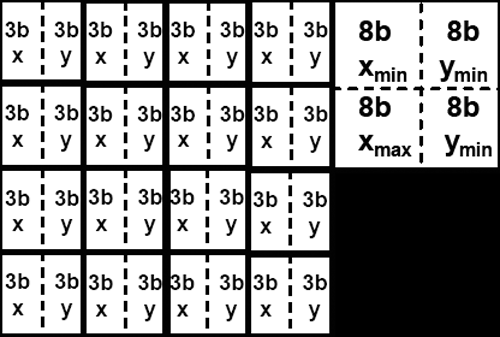ATI Radeon X800 Pro and XT Platinum Edition: R420 Arrives
by Derek Wilson on May 4, 2004 10:28 AM EST- Posted in
- GPUs
A New Compression Scheme: 3Dc
3Dc isn't something that's going to make current games run better or faster. We aren't talking about a glamorous technology; 3Dc is a lossy compression scheme for use in 3D applications (as its name is supposed to imply). Bandwidth is a highly prized commodity inside a GPU, and compression schemes exist to try to help alleviate pressure on the developer to limit the amount of data pushed through a graphics card.
There are already a few compressions schemes out there, but in their highest compression modes, they introduce some discontinuity into the texture. This is acceptable in some applications, but not all. The specific application ATI is initially targeting for use with 3Dc is normal mapping.
Normal mapping is used in making the lighting of a surface more detailed than is its geometry. Usually, the normal vector at any given point is interpolated from the normal data stored at the vertex level, but, in order to increase the detail of lighting and texturing effects on a surface, normal maps can be used to specify the way normal vectors should be oriented across an entire surface at a high level of detail. If very large normal maps are used, enormous amounts of lighting detail can produce the illusion of geometry that isn't actually there.

Here's an example of how normal mapping can add the appearance of more detailed geometry
In order to work with these large data sets, we would want to use a compression scheme. But since we don't want discontinuities in our lighting (which could appear as flashy or jumpy lighting on a surface), we would like a compression scheme that maintains the smoothness of the original normal map. Enter 3Dc.

This is an example of how 3Dc can help alieve continuity problems in normal map compression
In order to facilitate a high level of continuity, 3Dc divides textures into four by four blocks of vector4 data with 8 bits per component (512bit blocks). For normal map compression, we throw out the z component which can be calculated from the x and y components of the vector (all normal vectors in a normal map are unit vectors and fit the form x^2 + y^2 + z^2 = 1). After throwing out the unused 16 bits from each normal vector, we then calculate the minimum and maximum x and minimum and maximum y for the entire 4x4 block. These four values are stored, and each x or y value is stored as a 3 bit value selecting any of 8 equally spaced steps between the minimum and maximum x or y values (inclusive).

The storage space required for a 4x4 block of normal map data using 3Dc
the resulting compressed data is 4 vectors * 4 vectors * 2 components * 3 bits + 32 bits (128 bits) large, giving a 4:1 compression ratio for normal maps with no discontinuities. Any two channel or scalar data can be compressed fairly well via this scheme. When compressing data that is very noisy (or otherwise inherently discontinuous -- not that this is often seen) accuracy may suffer, and compression ratio falls off for data that is more than two components (other compression schemes may be more useful in these cases).
ATI would really like this compression scheme to catch on much as ST3C and DXTC have. Of course, the fact that compression and decompression of 3Dc is built in to R420 (and not NV40) won't play a small part in ATI's evangelism of the technology. After all is said and done, future hardware support by other vendors will be based on software adoption rate of the technology, and software adoption will likely also be influenced by hardware vendor's plans for future support.
As far as we are concerned, all methods of increasing apparent useable bandwidth inside a GPU in order to deliver higher quality games to end users are welcome. Until memory bandwidth surpasses the needs of graphics processors (which will never happen), innovative and effective compressions schemes will be very helpful in applying all the computational power available in modern GPUs to very large sets of data.










95 Comments
View All Comments
ZobarStyl - Tuesday, May 4, 2004 - link
Jibbo I thought that the dynamic branching capability as part of PS3.0 could make rendering a scene faster because it skips rendering unneccessary pixels and thus could offer an increase in performance, albeit a small one. In an interview one of the developers of Far Cry said that there weren't many more things that PS3.0 could do that 2.0 can't, but that 3.0 can do things in a single pass that a 2.0 shader would have to do in multiple passes. The way he described it, the real pretty effects can come in later but a streamlined (read: slightly faster) shader could very well improve NV40 scores as is. This seems kind of analogous to the whole 64-bit processor ordeal going on; Intel says you don't need it, but then most articles show higher scores from A64 chips when they are in a 64 bit OS, so basically if you streamline it you can run a little bit faster than in less efficient 32-bit.In the end, it'll still be bitter fanboys fighting it out and buying whatever product their respective corporation feeds them, despite features or speeds or price or whatever. Personally, like I said before, I'll wait and see who really ends up earning my dollar.
Anyway, thanks for keeping me on my toes though, jib...I can't get lazy now... =)
Barkuti - Tuesday, May 4, 2004 - link
From my point of view, the 6800U is superior high end hardware. Folks, you don't need to be that intelligent to understand that if ATI needs 520 Mhz to "beat" nVidia's 400 MHz chip, as it will need to overclock proportionally to keep the same level of performance that means it will need a good bunch of extra MHz to stay at least on par on the overclocking front.I think the final revision of the 6800U will manage 500 MHz overclocks or around (probably more if they deliberately set the initial clock low waiting for ATI), so ATI's hardware may need around 650 Mhz, which I doubt it'll make. As for the power requirements, sure ATI is the winner, but the nVidia's card can be fed with more standard PSU's than they claim; I just think they played on the safe side.
Oh, sure, power may be a limiting factor when oc'ing the 6800U, but the reality is that people who buy these kind of harware already has top end computer components (including the PSU), so no worries here also.
And finally speaking, I think PS 3.0 will make some additional difference. With the possibility to somewhat enhance shader performance and the superior displacement mapping effect, it may give it the edge in at least a handful of games. We'll see.
"Just my 2 cents"
Cheers
Staples - Tuesday, May 4, 2004 - link
Everyone be sure to check out Tom's review. Looks like the X800 did better here than it did against the 6800. I have seen other reviews and the X800 doesn't really seem as fast in comparison as it does here.Anyway, it is a lot faster than I though. The 6800 was impressive but it seems that the reason it does really well in some games and not so great in others is because some games have NVIDIA specific code that the 6800 takes advantage of very well.
UlricT - Tuesday, May 4, 2004 - link
wtf? the GT is outperforming the Ultra in F1 Challenge?jibbo - Tuesday, May 4, 2004 - link
Agree with you all the way on the fanboys, ZobarStyl.Just wanted to point out that PS3.0 is not "faster" - it's simply an API. It allows longer and more complex shaders so, if anything, it's likely to be "slower." I'm guessing that designers who use PS3.0 heavily will see serious fill-rate problems on the 6800. These shaders will have potentially 65k+ instructions with dynamic branching, a minimum of 4 render targets, 32-bit FP minimum color format, etc - I seriosuly doubt any hardcore 3.0 shader programs will run faster than existing 2.0 shaders.
Clearly a developer can have much nicer quality and exotic effects if he/she exploits these, but how many gamers will have a PS3.0 card that will run these extremely complex shaders at high resolutions and AA/AF without crawling to single-digit fps? It's my guess that it will be *at least* a year until games show serious quality differentiation between PS2.0 and PS3.0. But I have been wrong in the past...
T8000 - Tuesday, May 4, 2004 - link
I think it is strange that the tested X800XT is clocked at 520 Mhz, while the 6800U, that is manufactured by the same taiwanese company and also has 16 pipelines, is set at 400 Mhz.This suggests a lot of headroom on the 6800U or a large overclock on the X800XT.
Also note that the 6800U scored much better on tomshardware.com (HALO 65FPS@1600x1200), but that can also be caused by their use of the 3.2 Ghz P4 instead of a 2.2 Ghz A64.
ZobarStyl - Tuesday, May 4, 2004 - link
I love seeing these fanboys announce each product as the best thing ever (same thing happened with the Prescott, Intel fanboys called it the end of AMD and the AMD guys laughed and called it a flamethrower) without actually reading the benches. NV won some, ATi won some. Most of the time it was tiny margins either way. Fanboys aside, this is gonna be a driver war nothing more. The biggest margin was on Far Cry, and I'm personally waiting on the faster PS3.0 to see what that bench really is. This is a great card but price drops and drivers updates will eventually show us the real victor.jibbo - Tuesday, May 4, 2004 - link
If I had to guess, DX10 and Longhorn will coincide with the release of new hardware from everyone.Akaz1976 - Tuesday, May 4, 2004 - link
Just thought of something. If i am reading AT review right, ATi now has milked the original Radeon9700 architecture for nearly 2 years (sure says a lot of good things about the ArtX design team).Anyone know when the true next gen chip can be expected?
Akaz
Ilmater - Tuesday, May 4, 2004 - link
---------------------------------------Hearing about the 6850 and the other Emergency-Extreme-Whatever 6800 variants that are floating about irritates me greatly. Nvidia, you are losing your way!
Instead of spending all that time, effort and $$ just to try to take the "speed champ" title, make your shit that much cheaper instead! If your 6800 Ultra was $425 instead of $500, that would give you a hell of alot more market share and $$ than a stupid Emergency Edition of your top end cards... We laugh at Intel for doing it, and now you're doing it too, come fricking on...
--------------------------------------------
This is ridiculous!! What do you think the XT Platinum Edition from ATI is? The only difference is that nVidia released first, so it's more obvious when they do it than when ATI does. I'm not really a fanboy of either, but you shouldn't dog nVidia for something that everyone does.
Plus, if nVidia dropped their prices, ATI would do the same thing. Then nVidia would be right back where it was before, but they wouldn't be making any money on the cards.